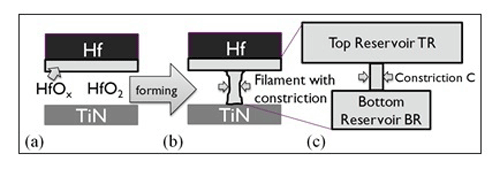Imecs ‘hourglass’ model presented at IEDM 2012
Imec successfully models set/reset processes in HfO2 RRAM
Imec presents a new ‘hourglass’ model for modeling low-current filamentary switching in amorphous HfO2 RRAM. The model describes the set and reset processes as a dynamic oxygen vacancy flow between two vacancy reservoirs connected by a narrow constriction. This way, it reproduces all main features of RRAM operation and allows identifying major reliability challenges such as endurance failure. Being fully analytical, the new model can be implemented in a circuit simulator.

Imec proposes a completely new set/reset model to describe the switching mechanism of HfO2 resistive RAM or RRAM. This new promising type of memory relies on the voltage-controlled resistance change of a conductive filament in the dielectric of a metal-insulator-metal stack (i.e., TiN/HfO2/Hf/TiN). Unlike other models that rely on simple resistive behavior, the new model implements a quantum point contact model to describe electronic conduction. This allows capturing all main features of HfO2 RRAM device operation, especially in the low-current operation range which is relevant for practical application of RRAM devices.
The set and reset processes are modeled as a dynamic oxygen vacancy flow between two vacancy reservoirs connected by a narrow constriction – like sand moving in an hourglass. These oxygen vacancies have earlier been identified as the mobile defect species responsible for electrical conduction. In the model, the filament is described as a volume of sub-stoichiometric HfOx, present between the Hf electrode and HfO2 dielectric. Reset is modeled as a dynamic balance between an upward and downward vacancy flow, while the set process is modeled as an unbalanced filament growth bounded by the external compliance.
The dependence on time, voltage and forming conditions as described by this model is in good agreement with experiments using X-bar RRAM elements with a TiN/HfO2/Hf/TiN stack in a 1T-1R configuration. The model, being fully analytical, has also been implemented in a circuit simulator providing precise information on how RRAM devices behave in larger circuits under a variety of operation conditions. In addition, several reliability challenges can be readily identified. In particular, disturb phenomena in the low current state are explained as a delayed growth of the filament constriction. Endurance failure, for example, is understood as a local atomic relaxation event happening in the filament constriction, due to high local temperature by Joule heating during switching. The local atomic relaxation degrades the mobility of the oxygen vacancies, leading to a gradual set failure. The hourglass model provides guidelines as to how the endurance as well as the resistance window can be maximized.
Stochastic fluctuations of the vacancy movement can also be included into the model, resulting in accurate simulations of the complete resistance distributions in both ON and OFF state. This makes the hourglass model a unique modeling tool for the further optimization and engineering of RRAM devices.
The hour glass model has been presented at the 2012 VLSI Symposium, the reliability aspects of RRAM devices have been presented at the IEEE International Electronic Devices Meeting (IEDM 2012).
Advertisement
Learn more about Imec





